WRL Peace Calendars Featuring Children’s Voices and Thoughts
I write this overview of the WRL peace calendars focused on young people as tens of thousands of them are now facing the horrors of war. Thus, some of the children’s personal statements in the calendars have a heartbreaking immediacy. Still, through descriptions of support, service, resistance projects, and individual actions undertaken by an impressive number of youth around the world, the calendars also convey hope for the future.
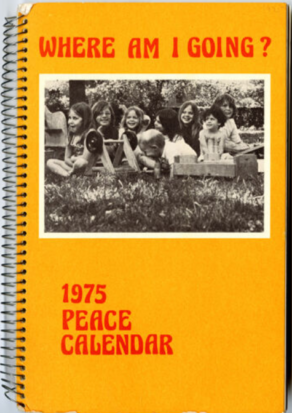
The first of them, Where Am I Going: A Joyous Child Today…A Peaceful World Tomorrow (1975), deals with children living in peaceful parts of the world, and presents ways to make their lives more rewarding. Reflecting the thinking of the white middle-class counterculture of the anti-Vietnam War movement, the calendar privileges children’s choices and freedom over their need to feel safe. For example, it cites a 16-year-old who questioned the validity of traditional education. And it advocates “economic power” for children, including their right to work, but not their right to be protected from forced labor or their right to healthy food and adequate shelter.
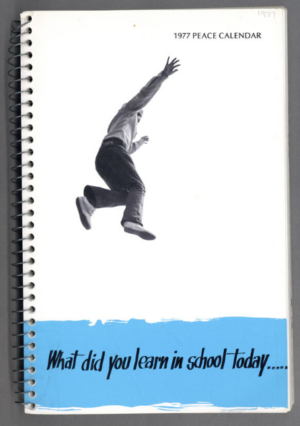
Similarly, Jonathan Kozol’s introduction to What Did You Learn in School Today: A Statement on the Liberation of Education (1977) refers to traditional schools where students “learn blind obedience and servile self-abasement in the face of ‘orders from above.’” The calendar does not, however, report that thousands of children are prevented from learning for many illegitimate reasons.
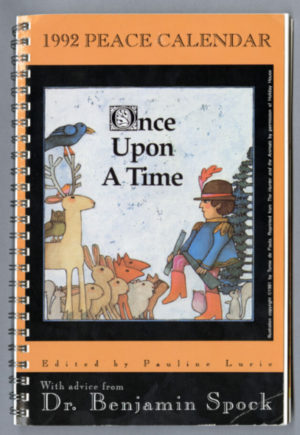
Once Upon a Time: An Illustrated Selection of Children’s Books Concerning Peace, Justice and the Environment (1992) is an eclectic mix of words and art consciously promoting equality, with Pete Seeger’s song “My Rainbow Race” as its de facto theme. Many entries are aspirational, such as acclaimed poet Lucille Clifton’s “We and They”: “…and every They is actually Us.” But “Kid’s Peace Song,” by Pete Alsop, brings readers back to a different reality with a message from children: “We love to laugh and play and run…We’re all afraid of bombs and guns, We know that one fight leads to more.”
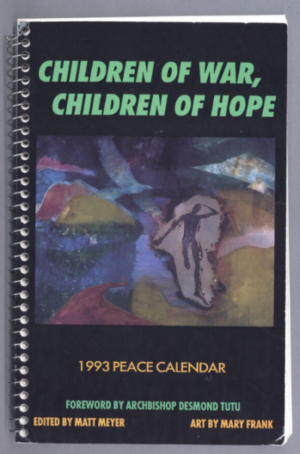
Children of War, Children of Hope (1993), named for an organization founded in Brooklyn, NY, has an international focus and thus presents a darker picture of children’s lives. The calendar comprises quotes from members of the organization, with young people from around the world sharing their war experiences, organizing and resistance activities, and plans for a future without war. The youths expressed hope for themselves, as one contributor reported: “We the young people in South Africa…realize the future is ours.” Too, they expressed hope for the planet, as articulated by a Lebanese teenager: “I wish there was one big country where all can live in peace and justice.”
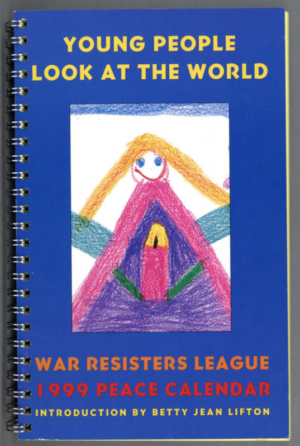
In Young People Look at the World (1999) children wrote and drew about what they saw around them. In their writings, both war and peace existed in their lives: “In the distance is the sound of war, but in the girl’s heart is the sound of peace,” wrote a fifteen-year-old. “War is like a flame burning everything up./Peace is like water putting out the flames,” said another girl. But the children’s art, much of it in crayon by the youngest contributors, expressed more hope for the future: their drawings, embracing both unity and diversity, showed children of different races playing together and holding hands, with captions saying “friends forever.”
Other calendars with different themes include entries on the concerns of children and youth. 75 Years of Nonviolent Resistance (1998) describes WRL’s 1994 YouthPeace Campaign, which brought together our Stop War Toys program and counter-recruitment efforts. The calendar demonstrates a new organizational emphasis on domestic violence and militarism of youth. Lastly, Not Your Fodder: Organizing Against the Militarization of Youth (2011) is a compilation of anti-recruitment organizations around the country that provide information about the military to youth and families.
In all, these calendars reflect the universal difficulties of growing up safely in a violent world and becoming a moral and nonviolent adult in a world that models neither.
–Wendy Schwartz
An activist with WRL for over 50 years focused on the role of women in the organization and everywhere, Wendy Schwartz is proud to have crafted WRL’s statement on freedom of choice.
WRL’s permanent repository at The Swarthmore College Peace Collection contains a set of WRL peace calendars, recently digitized and made available online as part of The War Resisters League Publications Digital Collection. This blog is part of a series of blogs posts focusing on the WRL peace calendars.
Share



